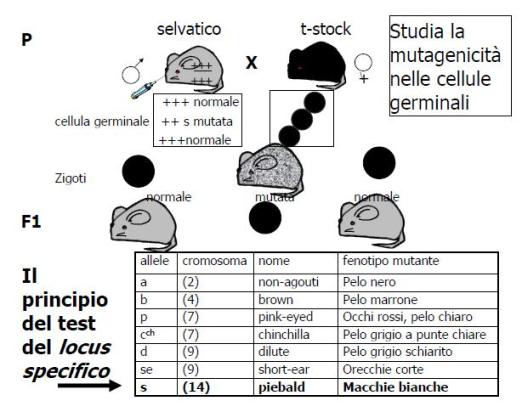Quanto è utile/interessante questa discussione:
| Autore |
Discussione |
|
|
Giulia_pv
Nuovo Arrivato

2 Messaggi |
 Inserito il - 07 marzo 2009 : 14:02:25 Inserito il - 07 marzo 2009 : 14:02:25




|
ciao a tutti!
sto preprando l'esame di genetca2 e ho qualche problema con 2 test di mutagenesi: il test degli "x attaccati" in drosophila e il test locus specifico sui topi!
sui miei libri ho trovato poche informazioni e confuse..qualcuno può darmi una mano?
grazie mille in anticipo!
|
|
|
|
|
GFPina
Moderatore
    

Città: Milano

8408 Messaggi |
 Inserito il - 07 marzo 2009 : 20:54:45 Inserito il - 07 marzo 2009 : 20:54:45





|
Il test degli X attaccati??? 
Mai sentito chiamare così, comunque penso si riferisca al test di Muller sulle mutazioni letali legate al sesso in Drosophila:
http://www.molecularlab.it/forum/topic.asp?TOPIC_ID=3086
Test di recessivi letali legati al sesso in Drosophila
Riguardo al test del locus specifico in topo:
Citazione:
da: The specific locus test (Jackson Laboratory)
The experiments performed by Russell and Carter, and other colleagues who followed in their footsteps, were designed to obtain discrete values for the mutagenic potential of different radiation protocols. Rather than attempt to examine all animals for all effects of a particular irradiation protocol (as was common in earlier experiments), these mouse geneticists chose instead to look only at the small fraction of animals that were mutated at a small set of well-defined "specific" loci. The rationale for the "specific locus test" was that effects on individual loci could be more easily quantitated and that the limited results obtained could still be extrapolated for an estimate of whole genome effects. Russell decided that mutation rates should be followed simultaneously at a sufficient number of loci to distinguish and avoid problems that might be caused by locus-to-locus variations in sensitivity to particular mutagens. He decided further that the same set of loci should be examined in each experiment performed. The seven loci chosen to be followed in the specific locus test were defined by recessive mutations with visible homozygous phenotypes that were easily distinguished in isolation from each other, and had no effect on viability or fertility. The seven loci are agouti (a is the recessive non-agouti allele), brown (b), albino (c), dilute (d), short-ear (se), pink-eyed dilution (p), and piebald (s). A special "marker strain" was constructed that was homozygous for all seven loci.
In its simplest form, the specific locus test is carried out by mating females from the special marker strain to completely wild-type males that have been previously exposed to a potential mutagen. In the absence of any mutations, offspring from this cross will not express any of the seven phenotypes visible in the marker strain mother. However, if the mutagen has induced a mutation at one of the specific loci, the associated mutant phenotype will be uncovered. This test is very efficient because it only requires a single generation of breeding and visual examination is all that is required to score each animal.
Although recessive mutations at all loci other than the specific seven will go undetected in the first generation offspring from this cross, it is possible to detect a dominant mutation at any locus so long as it is viable and produces a gross alteration in heterozygous phenotype such as a skeletal or coat color change. One should realize that the most common effect of any undirected mutagen will be to "knock-out" a gene and, in the vast majority of cases, the resulting null allele will be recessive to the wild-type. There is, however, a very small class of loci at which null alleles will act in a dominant or semidominant fashion to wild-type. These "haplo-insufficient" phenotypes are presumably caused by a developmental sensitivity to gene product dosage. Among the best characterized of the dominant-null mutations are the numerous ones uncovered at the T locus — which result in a short tail — and the W locus — which result in white spotting on the coat.
immagine da:MUTAGENESI e CANCEROGENESI CHIMICA (pdf)

  |
 |
|
|
Giulia_pv
Nuovo Arrivato

2 Messaggi |
 Inserito il - 08 marzo 2009 : 11:04:53 Inserito il - 08 marzo 2009 : 11:04:53




|
ciao!per quanto riguarda il test locus specifico grazie mille!
l'altro non è il test ClB, è un altro che la mia prof ha chiamato degli "x attaccati" perchè si fa incrociando una drosophile femmina con 2 cromosomi x attaccati con un maschio esposto ad agenti mutageni, ma purtoppo non riesco a trovare nessuna informazione.. :(
comunque ancora grazie per l'altra risposta! ;)
giulia |
 |
|
|
GFPina
Moderatore
    

Città: Milano

8408 Messaggi |
 Inserito il - 08 marzo 2009 : 19:38:40 Inserito il - 08 marzo 2009 : 19:38:40





|
Ah ok! Non mi ricordo neanche se l'avevo studiato io questo!
Comunque l'unica e' cercare in Inglese: "mutagenesis Drosophila "attached X""
Trovi un sacco di pubblicazioni su questo tipo di mutagenesi.
Comunque qua dovresti trovare una spiegazione:
Mutagens in genetic dissection
sono un po' di fretta e non ho letto con calma.
Spero sia chiaro!
Ciao  |
 |
|
| |
Discussione |
|
|
|
Quanto è utile/interessante questa discussione:
| MolecularLab.it |
© 2003-18 MolecularLab.it |
 |
|
|






